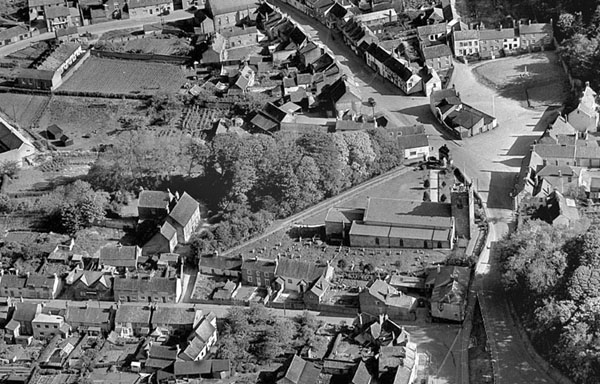





Hunmanby Archives
Enter Here
Where you will find an ever increasing library covering all aspects of Hunmanby's history

THE TEMPERATURE IN HUNMANBY IS
Little is known about this period, Hunmanby being an earlier Saxon settlement with almost certainly a church. After the Norman "harrowing of the North' in 1080, Hunmanby Manor was given to Gilbert de Gant, a Norman overlord, of Bardney in Lincolnshire, for his assistance in the above campaign .A Norman 'motte and bailey' was built on what is today (2016) Castle Hill. An aisle-less church was erected which over the centuries was modified to its present design. The de Gant family remained in Hunmanby for many years, Gilbert's son Walter, a great church benefactor, founded and endowed the Augustinian Priory at Bridlington. The de Gant's, as Lords of the Manor, granted two charters for 'fairs' and claimed all that was washed up in Filey Bay above the low water mark. The small fishing community of Filey (then) being part of the Hunmanby Manor.
Gent's 'History of York' 1730, mentions Hunmanby as 'one of the twelve market
towns in the East Riding'. In 1629 the Osbaldeston family bought the
Westroppe manor and during the next 200 years gradually obtained more and
more land. This is indicated by them gaining the Lordships and Parishes of
Filey, Muston, Reighton, Wold Newton, Fordon, Foxholes, Langtoft, North
Burton and Thwing. Only the male side could inherit estates, and gradually
the direct Osbaldeston line died out. Humphrey Brooke of Brayton, Selby,
the grandson of Theodosia Osbaldeston was the next in line and he inherited
the Hunmanby Estate in 1770. He then changed his name to Humphrey
Osbaldeston-Brooke.
Humphrey Osbaldeston-Brooke was 24 and remained Lord of the Hunmanby
(and associate) manors for 65 years, dying aged 90. In that period he formed
the Hunmanby agricultural eastate of approximately 8,500 acres by the
enclosure of 1809, making the present landscape of farms and roads. Hunmanby
Hall, built in the late 1600's by his predecessors was altered by the addtion
of the South and North wings, the Hall Park bounded by trees etc.
He formed 'The Volunteers', an artillery force, during the Napoleonic wars
for local defence. Together with the then vicar, Archdeacon Wrangham,
a school was formed 'on Lancastrian lines'.
On his death the estate moved over to two more 'great-grandsons', first
Betram and in 1842 his brother Robert Mitford. Admiral of the Red RN. Who
was the last true Lord of the Manor to live in Hunmanby Hall.
A fine man, whose daughter married Tyson (later Lord) Amhurst - she
designed and painted the shields which were given by her husband,
that still grace the interior of All Saints, Church. On the Admiral's
death, his villagers voluntarily subscribed for a memorial. It is
'the Admirals arch', gateway to Hunmanby church.
Now the estate moved to the Mitford family who lived in Mitford Castle,
Durham. Hunmanby Hall was let to several tenants, the most important being
Lord Cecil who had married the Admiral's eldest grand-daughter. He was
comptroller to H.R.H Princess Beatrice, Queen Victoria's cousin and for
the latter years of the nineteenth century, Hunmanby Hall played host to
Royalty during the summer season.
About 1900, Sir Dennis Readett Bayley, newly appointed High Sheriff of
Yorkshire rented the Hall. He eventually bought the estate and sold some parts
to tenants and others in 1920-21. Hunmanby Hall was then purchased by
Lord Nunburnholme but went back onto the market in 1925. Finally it was
sold to the Methodist Education Committee and altered into a Girls
boarding school in 1928. This school closed in 1992.
During the nineteenth century, Hunmanby had five places of worship. All
Saint's Church, Baptist Chapel (with it's own graveyard), Wesleyan and
Primitive Methodist Chapels and the Temperance Society.
There were also several 'Dame Schools', the last operating up to 1920.
The original Church school was re-housed in Stonegate in 1905 and later
still in its present premises in the 1970's. Land at Primrose Valley was
sold and housed three boarding Schools.
The railway came in 1847 and a brickworks
established alongside shortly
afterwards. Agriculture entered the steam age with traction engines
etc and Messrs.W. Parker and Sons built an engineering works next to
the Station. Parker's also operated a brickworks and finally took over
the original brickworks, building kilns and operating with a portable
steam engine. Due to the farming requirements, Hunmanby also had three
ropeworks which supplied the farms and fishing industry locally.
During the Local Government Acts of the late 1800's, Hunmanby was
demoted into a village, with a Parish Council. Filey, now much enlarged
became the local 'town' with an Urban District Council (pre-1974).
Development started between the wars and after World War 2, in the
1960-70's many new estates were added, together with many new roads,
the population doubling.
Today, 1999 and on the verge of the New Millennium Hunmanby is a well
balanced community, still with an agriculture background but becoming
more and more a retirement area.
